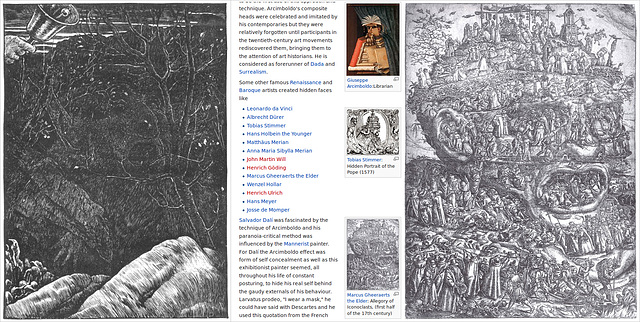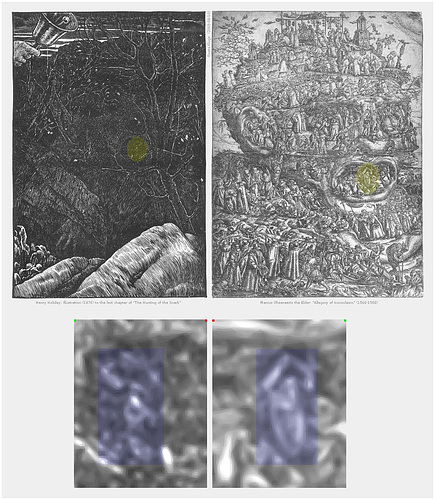The second Snark finding
John Martin' s "The Bard" prepared for analysis
John Martin's Bard and Henry Holiday's Snark Illus…
The Banker and The Bonnetmaker
布列德
Ear & Embryo
Firehouse in Tainan
Fun with Allusions
Snarking or Gnashing
Illustration for "Violinschule" by Henry Holiday
Visit of Saint Anthony to Saint Paul
Cooling down in Taipei
Grünewald and Holiday
He stood on his head till his waistcoat turned red
Alice is gone
Easter Greeting
Who inspired who?
W. R. Hill: Alice in Wonderland
Liddell & Boyd (Alice in the looking glass works)…
Alice & Cheshire Cat by Tenniel, Forests by Hill a…
Alice and the Cheshire Cat
The Residence of Henry Holiday
Darwin's snarked Study
Dancing in Rio 2016
Holiday - Millais - Anonymous - Galle; detail
Bonomi Edward Warren: Variations on Trees and Shad…
Eagle and Star
The Baker's Dear Uncle
Darwins snarked Study
The Boojum even may lurk on a ginger nuts tin.
Paradise Lost and the Beaver's Lesson
HMS Beagle
Napoleon on board the HMS Bellerophon to St. Helen…
Ceci n'est pas une cloche
M. C. Escher's allusion(?) to John Martin's "The B…
Stachelschön
Dream Snarks
Carroll's Barrister's Dream
FFT 16
What is Quantum Mechanics?
Simplified Physics: Forget about E=mc²
The Billiard Marker & Henry George Liddell
Snarked Workplace
Herbs & Horses
White Spot
See also...
See more...Keywords
Authorizations, license
-
Visible by: Everyone -
All rights reserved
-
2 851 visits
About my Snark hunt


===== How I got into Snark hunting =====
In December 2008, I searched for “Hidden Faces” in the Wikipedia. I wanted to see whether an illustration by Henry Holiday (left) to Lewis Carroll’s The Hunting of the Snark was mentioned there. (Now it is.) But instead of that I found Gheeraert's Allegory of Iconoclasm (right, aka The Image Breakers) in the Wikipedia article on hidden faces. And then I saw a little rhombic pattern in the “mouths” of the “heads” depicted in both illustrations. The Snark hunt had begun.
left:
2009: Illustration by Henry Holiday to fit the eight in Lewis Carroll's The Hunting of the Snark
(This is the 2007 version of an image in ebooks.adelaide.edu.au/c/carroll/lewis/snark/#fit8.)
center:
2008-12-16: Detail from "Hidden Faces" in en.wikipedia.org,
en.wikipedia.org/w/index.php?title=Hidden_faces&oldid=258354510
right:
Marcus Gheeraerts the Elder, Allegory of Iconoclasm, c.1566–1568 etching 15” x 10.4”, British Museum, London.
commons.wikimedia.org/wiki/File:Gheerhaets_Allegory_iconoclasm.jpg
(In December 2008 the image was smaller: upload.wikimedia.org/wikipedia/commons/archive/f/f5/20100214083045!Gheerhaets_Allegory_iconoclasm.jpg, but even there you can see the detail which cought my attention.)

(The blur is intentional. It removes unecessary details.)
In December 2008, I searched for “Hidden Faces” in the Wikipedia. I wanted to see whether an illustration by Henry Holiday (left) to Lewis Carroll’s The Hunting of the Snark was mentioned there. (Now it is.) But instead of that I found Gheeraert's Allegory of Iconoclasm (right, aka The Image Breakers) in the Wikipedia article on hidden faces. And then I saw a little rhombic pattern in the “mouths” of the “heads” depicted in both illustrations. The Snark hunt had begun.
left:
2009: Illustration by Henry Holiday to fit the eight in Lewis Carroll's The Hunting of the Snark
(This is the 2007 version of an image in ebooks.adelaide.edu.au/c/carroll/lewis/snark/#fit8.)
center:
2008-12-16: Detail from "Hidden Faces" in en.wikipedia.org,
en.wikipedia.org/w/index.php?title=Hidden_faces&oldid=258354510
right:
Marcus Gheeraerts the Elder, Allegory of Iconoclasm, c.1566–1568 etching 15” x 10.4”, British Museum, London.
commons.wikimedia.org/wiki/File:Gheerhaets_Allegory_iconoclasm.jpg
(In December 2008 the image was smaller: upload.wikimedia.org/wikipedia/commons/archive/f/f5/20100214083045!Gheerhaets_Allegory_iconoclasm.jpg, but even there you can see the detail which cought my attention.)

(The blur is intentional. It removes unecessary details.)
- Keyboard shortcuts:
Jump to top
RSS feed- Latest comments - Subscribe to the comment feeds of this photo
- ipernity © 2007-2024
- Help & Contact
|
Club news
|
About ipernity
|
History |
ipernity Club & Prices |
Guide of good conduct
Donate | Group guidelines | Privacy policy | Terms of use | Statutes | In memoria -
Facebook
Twitter

After some time I got interested in the whole poem. It was easy to find online:
ebooks.adelaide.edu.au/c/carroll/lewis/snark. I forked their Snark edition, added line numbers, Carroll's dedication to Gertrude Chataway and Carroll's Easter Greeting, which he tipped in at front end paper of the first Snark editions in April 1876.
My forked online edition is www.snrk.de/snarkhunt/. (eBooks Adelaide have improved their site. The images still are bad. I offered them to use my scans.) I also bought myself an old edition of The Hunting of the Snark. I read it several times, which already may be difficult for English readers, but surely is very challenging for a German.
But as in 1876 the book was sold as a childrens' book, I thought that the pictures should help to explain the text. As I always was interested in the fine (more or less) arts, I looked closer at the illustrations. So, like so many other readers before, I "discovered" the hidden face in Holiday's illustration to the last "fit" of The Hunting of the Snark.
So here we are again: The "hidden face".
In December 2008, I searched for “Hidden Faces” in the Wikipedia. I wanted to see whether an illustration by Henry Holiday (left) to Lewis Carroll’s The Hunting of the Snark was mentioned there. (Now it is.) But instead of that I found Gheeraert's Allegory of Iconoclasm (right, aka The Image Breakers) in the Wikipedia article on hidden faces. And then I saw a little rhombic pattern in the “mouths” of the “heads” depicted in both illustrations. The Snark hunt had begun.
Yes, this comment is similar to the one at the top of this page.
First: Maybe I am wrong. The allusions may be illusions.
Second: For the largest part of those 130 years there was no Internet. You had to walk to those images in order to see them. And prints were not cheap. But in 2008 I only needed a computer and access to the WWW. And I had tools to prepare images for comparison quickly.
Third: Perhaps I am not the first Snark hunter who discovered Henry Holiday's Snark allusions. Alfred Parsons may have discovered and continued Henry Holiday's game already in the year 1882:
¨¨¨¨¨¨¨¨¨¨¨¨¨¨¨¨¨ by Alfred Parsons (1882) ¨¨¨¨¨¨¨¨¨¨¨¨¨¨¨¨¨ by Henry Holiday (1876) ¨¨¨¨¨¨¨¨¨¨¨¨¨¨¨¨¨
Finally, I want to express my thanks to John Tufail and to Mahendra Singh (another Snark illustrator):
John's hint in his "Illuminated Snark" to a map which may be hidden in the front cover of the Snark guided me to the "Ditchley portrait" (Marcus Gheeraerts the Younger). I could relate it to the front cover illustration to Carroll's poem. This also gave me an idea to search for art which may have influenced the back cover illustration.
Mahendra's encouragement in early 2009 after he saw my first (and lousy) comparison got me going. As for allusions to other's work of art, the Canadian Indian German cryptomorphist at that time(but unknowingly) already worked like Henry Holiday (even though he doesn't like Holiday's illustrations too much). The difference: Holiday never talked about his allusions. Singh does so quite openly. Both artists have in common, that they not only create illustrations, they also teach how to see. Also it was Mahendra who drew my attention to the "Bone Player".
My use of informatics and mathematics has been mentioned in some comments on my Snark hunting.
Yes, I use computers and mathematical principles, but I neither invented the application of computer graphics to the analysis of drawings and paintings, nor did I invent using topology for such a comparison.
Computer graphics: I am just lucky that there is the GIMP. I just use it, the maths behind e.g. the Retinex filtering has been done by others. As for peoneering the application of computer graphics to arts, my thanks goes to Lillian Schwartz.
Mathematics: There often is a relation between Holiday's illustrations and the sources to which these illustarions are an allusion, which I call "topological match" (see a later comment). But that just is a term which I use to give this relation a name. I dont use any metrics etc. to quantify the "strength" of a match.